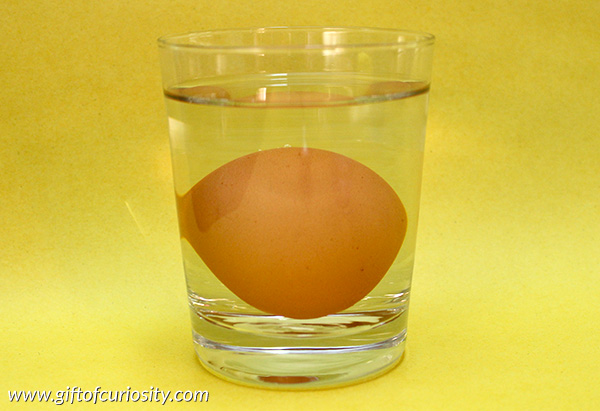This post may contain affiliate ads at no cost to you. See my disclosures for more information.
Have you ever noticed that it is easier to float in the ocean than in a swimming pool?
The reason for this has to do with the difference in density between pool water and salt water. Simply put, salt water is more dense than pool water.
But what does this mean?
Density is defined as mass per unit of volume. More casually, we can say that density is “the amount of stuff in a given amount of space.” So if you were to weigh 1 cubic cm of pool water and 1 cubic cm of ocean water, you would find that the ocean water weighs more.
Earlier this year I put together a comprehensive Density STEM Pack with nine different activities that build upon each other to progressively develop students’ understanding of density.
One of the activities in my Density STEM Pack is the floating egg, which gives kids an opportunity to change the density of water, and thereby make an object that usually sinks in water – an egg – float!
Note: Find more STEM activities on my Science Activities for Kids page!

To prepare for the floating egg experiment, gather the following materials:
- 2 glasses of water
- 2 eggs
- Stirring spoon
- 1 tablespoon
- Salt
- Optional: towel to mop up any spills

Gently place an egg into the first glass of water. Does it sink or float? (It should sink.)

Add about 6 tablespoons of salt to the second glass of water.

Stir until the salt dissolves, although the water may remain cloudy.

Gently place the second egg into the glass of salt water. Does sit sink or float? (It should float. If it does not, add more salt to the water.)

You can get instructions for this activity and several others in my Density STEM Pack.
Here is a sneak peak at the teacher instructions and student instructions for the Floating Egg activity:


Who is the Density STEM Pack appropriate for?
The activities in the Density STEM Pack can be adapted and used with children from preschool through middle school to have fun and learn important concepts about density.
The student worksheets provided for these activities are written for kids in fourth through eight grades, but a teacher or parent could easily adapt all but two of the activities for younger students by working directly with the students rather than asking them to follow the written instructions.
Truly, kids of all ages will have fun with all the activities in this pack!
Want a copy of my Density STEM Pack?
Add this product to your cart by clicking the button below!
More STEM activities for kids
More science posts from Gift of Curiosity:
- Bubble STEM activities
- Dancing raisins
- Advanced patterns worksheets
- Jumping colors science activity
- Crystallized snowflakes
- Introduction to probability
- Dissecting an apple
- What do ants like to eat?
- Make your own telescope
- Engineering challenges for kids
- The great baking soda and vinegar experiment
Find more great science activities on my Science Activities for Kids page and my Science Activities Pinterest board.




